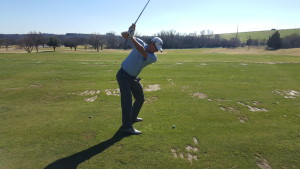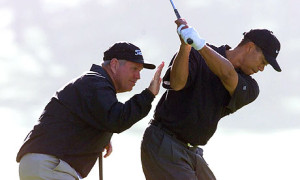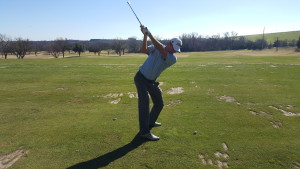One of the biggest and often most overlooked mechanical flaws is when the right elbow gets behind the
torso in the backswing. It is commonly referred to as the “Flying Elbow”. When you hear flying elbow
many of you will think of Jack Nicklaus. Yes, he did have a flying elbow, and he obviously made it work
quite well. Nicklaus was a gifted, strong athlete that spent countless hours on his craft. Most of you
don’t have the luxury of putting in the hours that Nicklaus did, so making your swing as mechanically
sound as possible is your best bet.
An elbow that gets behind the body in most cases will look like a flying elbow at the top of the swing,
but some better players can get the elbow behind them in the backswing, and somewhat correct it so
the elbow points at about a 45 degree angle at the top of the backswing. Just because your elbow isn’t
flying, doesn’t mean it isn’t getting behind you.
When the elbow gets behind you in the backswing, it causes the shaft to get overly steep. Now going
back to Jack Nicklaus, he was famous for a vertical backswing, and that is what a “flying elbow” gets you.
When the shaft gets steep in the backswing, it will result in either the golfer having to make a
compensatory move to shallow the shaft or the shaft will come down steep.
The compensatory move to shallow the shaft is usually “early extension” which can cause a host of
ballstriking problems, and leads to inconsistency. When the shaft comes down too steep it can result in
slicing, shanking, pulls and fat shots. Needless to say; developing proper right arm movement, getting
the elbow and shaft in a good place, is a key to great golf. The majority of elite players have the shaft
pointing left of the target, and the trail elbow under their trail palm at the top of their backswing with
their irons.
Now to get the shaft and elbow in the position that we desire, the trail arm has to externally rotate
during the backswing. If it doesn’t externally rotate then the shaft will steepen, the elbow will get
behind the body, and you will have your flying elbow.
There are two drills that produce results and give you the correct feel. The first drill you place a small
ball between your arms and make backswings. The ball forces the elbows to stay together and the trail
arm to externally rotate. It can be cumbersome and inconvenient to carry a ball around, so that is
where a SuperFlex band comes in.
The SuperFlex “Flying Elbow” drill is great because all it requires is a SuperFlex band. You simply loop the
SuperFlex band over both shoulders like a backpack. Then hook the SuperFlex band around both
thumbs, extend the SuperFlex band in front of you, and take your golf grip. From there you make a
backswing and the SuperFlex band should stay on the outside of your trail arm. The SuperFlex band
forces your trail arm to externally rotate and fold at a 90 degree angle directly under the palm of your
trail arm.
Video – Master Instructor Andrew Park
If you have poor trail arm mechanics it is vital that you work on correcting it. Do the SuperFlex band drill
in front of a mirror so you can associate the feel with a visual image, and keep repeating it until it
becomes permanent. Alternate between the SuperFlex band drill and a regular swing so you can transfer
the feels. You will experience a new level of ballstriking when you have conquered this flaw.
Check out the SuperFlex Golf Swing Kit
The SuperFlex band used for this drill is from the resistance band line and can be purchased here
Blog written by www.billymellon.com



